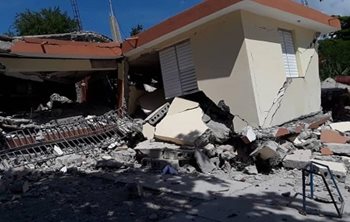Photos courtesy: IFRC
In a country hit by several significant emergencies in recent years, the 7.2 magnitude earthquake that struck Haiti on August 14 caused more damage, destroying critical infrastructure – including medical facilities, roads and bridges - resulting in more than 2,180 deaths, more than 12,200 injuries, and 298 people missing so far.
These figures are sadly expected to increase in the coming days. The Haitian government has declared a state of emergency for one month. Preliminary reports confirm that the earthquake also caused severe damage to infrastructure, including hospitals, hotels, schools, bridges, roads and other critical buildings, especially in Jeremie and Les Cayes. Religious buildings collapsed while the morning mass was being celebrated. The needs are immense.
In Grand’Anse, Nippes and Sud departments, 61,000 homes are destroyed and 76,000 severely damaged.
The Red Cross has been working to meet the urgent needs of people impacted since the first moments after the earthquake occurred. The Haitian Red Cross is currently prioritizing search and rescue, first aid, emergency health care and shelter, as well as psychosocial support. The Canadian Red Cross has sent a health humanitarian expert to Haiti to support assessments of health facilities, and our Country Representative in Haiti is working closely with the Haitian Red Cross and other Movement partners on how to best support response efforts.
The Canadian Red Cross is also sending non-food items for 500 families, including hygiene kits, jerrycans, buckets, tarpaulins, kitchen sets, shelter kits, and personal protective equipment (PPE). These items will be some of the first to arrive in Haiti to support those affected.
 The epicenter of the earthquake was near the town of Petit Trou de Nippes, some 160 km from central Port-au-Prince, with three main departments affected by the earthquake, South, Grand’Anse and Nippes, which were also impacted by Hurricane Matthew in 2016.
The epicenter of the earthquake was near the town of Petit Trou de Nippes, some 160 km from central Port-au-Prince, with three main departments affected by the earthquake, South, Grand’Anse and Nippes, which were also impacted by Hurricane Matthew in 2016.Then, two days later, on August 16, Tropical Depression Grace made landfall in Haiti causing heavy winds and rain which triggered mudslides and flooding to areas already affected by the earthquake and further exacerbating the impacts. The full extent of damage is still unknown as access to the affected region is limited, telecommunications systems are down, and security continues to pose a challenge.
The needs are immense. During the next four months, until the end of the Atlantic hurricane season on November 30, Haiti could be in the trajectory of other storms, depressions and hurricanes that could affect the areas hit by the earthquake. This situation compounds humanitarian needs in a country that has experienced several weather-related emergencies in the past decade and is now also responding to COVID-19. There are also concerns that the earthquake could exacerbate the island’s COVID-19 infection rate should displaced people be forced into closer confines.
The Canadian Red Cross has worked in Haiti for more than 30 years and continues to have a presence in Haiti, working with other Red Cross Movement partners on the ground to improve the lives of people and strengthen the capacity of the Haitian Red Cross.
Canadians wishing to help are encouraged to donate to the Haiti Earthquake Appeal. Donations will be used for immediate and ongoing relief efforts, long-term recovery, resiliency, and preparedness for future events in Haiti and impacted regions, including consequential events related to the earthquake. These activities and the impacted areas may evolve based on emerging needs and subsequent disasters.
Related stories:

